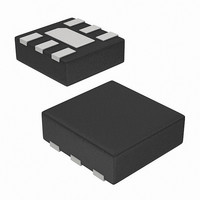ISL29012IROZ-T7 Intersil, ISL29012IROZ-T7 Datasheet - Page 7

ISL29012IROZ-T7
Manufacturer Part Number
ISL29012IROZ-T7
Description
IC SENSOR LIGHT-DGTL I2C 6-ODFN
Manufacturer
Intersil
Datasheet
1.ISL29012IROZ-EVALZ.pdf
(15 pages)
Specifications of ISL29012IROZ-T7
Wavelength
540nm
Output Type
I²C™
Package / Case
6-ODFN
Lead Free Status / RoHS Status
Lead free / RoHS Compliant
The transfer function effectively for each timing mode
becomes:
INTERNAL TIMING MODE
EXTERNAL TIMING MODE
Gain/Range, Range(k)
The Gain/Range can be programmed in the control register
to give Range(k) determining the FSR. Note that Range(k) is
not the FSR (see Equation 3). Range(k) provides four
constants depending on programmed k that will be scaled by
R
adjusts the FSR. This function is especially useful when light
conditions are varying drastically while maintaining excellent
resolution.
Number of Clock Cycles, n-bit ADC
The number of clock cycles determines “n” in the n-bit ADC; 2
clock cycles is a n-bit ADC. n is programmable in the command
register in the width function. Depending on the application, a
good balance of speed, and resolution has to be considered
when deciding for n. For fast and quick measurement, choose
the smallest n = 3. For maximum resolution without regard of
time, choose n = 15. Table 12 compares the trade-off between
integration time and resolution. See Equations 10 and 11 for the
relation between integration time and n. See Equation 3 for the
relation of n and resolution.
E
E
EXT
n = 3, 7, 11, or 15. This is the number of clock cycles
programmed in the command register.
Range(k) is the user defined range in the Gain/Range bit
in the command register.
R
pin.
DATA is the output sensor reading in number of counts
available at the data register.
2
Internal Timing Mode. For the External Timing Mode the
maximum number of counts is stored in the data register
named COUNTER.
COUNTER is the number increments accrued for between
integration time for External Timing Mode.
=
=
n
EXT
Range k ( )
----------------------------------------------------
Range k ( )
----------------------------------------------------
represents the maximum number of counts possible in
(see Table 9). Unlike R
COUNTER
is an external scaling resistor hardwired to the R
2
n
×
×
100kΩ
----------------- -
100kΩ
----------------- -
R
R
EXT
EXT
×
×
DATA
DATA
EXT
7
, Range(k) dynamically
(EQ. 4)
(EQ. 5)
EXT
ISL29012
n
External Scaling Resistor R
The ISL29012 uses an external resistor R
internal oscillator frequency, f
determines the f
device. f
proportional to R
constant is referenced to fixed constants 100kΩ and 655kHz
in Equations 6 and 7:
f
When the Range/Gain bits are set to Range1 or Range2,
f
are set to Range3 and Range4 by using Equation 8:
f
The automatic f
improvement of signal-to-noise ratio when detecting very low
lux signals.
Integration Time or Conversion Time
Integration time is the period during which the device’s
analog-to-digital ADC converter samples the photodiode
current signal for a lux measurement. Integration time, in
other words, is the time to complete the conversion of analog
photodiode current into a digital signal--number of counts.
Integration time affects the measurement resolution. For
better resolution, use a longer integration time. For short and
fast conversions, use a shorter integration time.
The ISL29012 offers user flexibility in the integration time to
balance resolution, speed and noise rejection. Integration time
can be set internally or externally and can be programmed in
the command register 00(hex) Bit 5.
f
R
OSC
OSC
OSC
OSC
TABLE 12. RESOLUTION AND INTEGRATION TIME
EXT
f
set. This is nominally 342kHz when R
f
are set. This is nominally 684kHz when R
OSC
OSC
15
11
n
7
3
1
1
2
runs at half speed compared to when Range/Gain bits
= 100kΩ
=
=
=
1 is oscillator frequency when Range1 or Range2 are
2 is the oscillator frequency when Range3 or Range4
OSC
1
-- -
2
1
-- - f
2
100kΩ
----------------- -
R
(
×
EXT
OSC
SELECTION
(ms)
100kΩ
----------------- -
12.8
0.05
t
, a dual speed mode oscillator, is inversely
200
R
0.8
INT
EXT
f OSC = 327kHz
OSC
2
OSC
×
EXT
)
684
RANGE1
×
. For user simplicity, the proportionality
, integration time and the FSR of the
adjustment feature allows significant
RESOLUTION
684
kHz
LUX/COUNT
kHz
0.06
15.6
250
1.0
OSC
EXT
. Consequently, R
0.025
(ms)
and f
t
100
6.4
0.4
INT
EXT
f OSC = 655kHz
EXT
RANGE4
EXT
OSC
is 100kΩ.
RESOLUTION
(LUX/COUNT)
to fix its
December 10, 2008
is 100kΩ.
16,000
1,000
62.5
EXT
2
FN6476.1
(EQ. 7)
(EQ. 6)
(EQ. 8)











